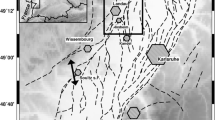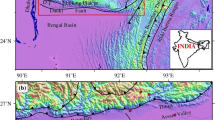Abstract
Digital seismograms continuously recorded from 1988 to 1992 by two stations of the RESNOM seismic network in northern Baja California, Mexico, were used to search for probable shear-wave anisotropic characteristics in the region of the Cerro Prieto fault. Shear-wave splitting was identified in many of the three-component records analyzed. We measured the polarization direction of the leadingS wave inside theS-wave window as well as the delay times between fast and slow phases on those records displaying shear-wave splitting. For station CPX, which is nearest the Imperial Valley region to the north, the preferred polarization direction found in this study (azimuth 180°±10°) coincides with the direction of the regional maximum compressive stress determined for the region. This polarization direction can be interpreted in terms of the “Extensive Dilatancy Anisotropy” model as the effect of vertical parallel aligned cracks. The preferred polarization direction measured at LMX, however, gives an azimuth of 45°±5°. Thus, it appears that faults and fractures aligned oblique to the main tectonic trend have a greater influence on the anisotropic characteristics of the crust south of Cerro Prieto volcano than that of the regional stress field. Time delays between slow and fastS waves observed at CPX appear constant from 1988 to 1992 while delays measured at LMX for the same interval indicate a small increase with time which cannot be attributed to azimuthal variations of paths.
Similar content being viewed by others
References
Aster, R. C., Shearer, P. M., andBerger, J. (1990),Quantitative Measurements of Shear-wave Polarizations at the Anza Seismic Network. Southern California: Implications for Shear-wave Splitting and Earthquake Prediction, J. Geophys. Res.95, 12.449–12.473.
Aster, R. C., Shearer, P. M., andBerger, J. (1991),Reply, J. Geophys. Res.96, 6415–6419.
Babuska, V., andCara, M.,Seismic Anisotropy in the Earth (Kluwer Academic Publishers, Dordrecht, Boston, London 1991).
Booth, D. C., andCrampin, S. (1985),Shear-wave Polarizations on a Curved Wavefront at an Isotropic Free Surface, Geophys J. R. Astr. Soc.83, 31–45.
Booth, D. C., Crampin, S., Lovell, J., andChiu, J.-M. (1989),Temporal Changes in Shear-wave Splitting during an Earthquake Swarm in Arkansas, J. Geophys. Res.95, 11151–11164.
Booth, D. C., Wyss, M., andGillard, D. (1992),Shear-wave Polarizations Alignments Recorded above the Kaoki Fault Zone, Hawaii, Geophys. Res. Lett.19, 1141–1144.
Bowman, J. R., andAndo, M. (1987),Shear-wave Splitting in the Upper Mantle Wedge above the Tonga Subduction Zone, Geophys. J. R. Astr. Soc.88, 25–41.
Chen, T.-C., Booth, D. C., andCrampin, S. (1987),Shear-wave Polarizations near the North Anatolian Fault. III. Observations of Temporal Changes, Geophys. J. R. Astr. Soc.91, 287–311.
Crampin, S. (1978),Seismic Wave Propagation through a Cracked Solid: Polarization as a Possible Dilatancy Diagnostic, Geophys. J. R. Astr. Soc.53, 467–496.
Crampin, S. (1985),Evaluation of Anisotropy by Shear-wave Splitting, Geophys.50, 159–170.
Crampin, S. (1987),The Basis for Earthquake Prediction, Geophys. J. R. Astr. Soc.91, 331–348.
Crampin, S., Booth, D. C., Evans, R., Peackock, S., andFletcher, J. (1990),Changes in Shear-wave Splitting at Anza near the Time of the North Palm Springs Earthquake, Geophys. Res.95, 11197–11212.
Crampin, S., Booth, D. C., Evans, R., Peacock, S., andFletcher, J. B. (1991a),Comments on “Quantitative Measurements of Shear-wave Polarization at the Anza Seismic Network, Southern California: Implications for Shear-wave Splitting and Earthquake Prediction” by Richard C. Aster, Peter M. Shearer and Jon Berger, J. Geophys. Res.96, 6403–6414.
Crampin, S., andLovell, J. H. (1991b),A decade of Shear-wave Splitting in the Earth's Crust: What Does it Mean? What Use we Make of it? and What Should we do Next?, Geophys. J. Int.107, 387–407.
Fonseca, H. L., De la Peña, A., Puente, I., andDíaz, E. (1981),Extensión del campo de Cerro Prieto y futuras zonas con probabilidades geotérmicas en el Valle de Mexicali. InProc. Third Symposium on the Cerro Prieto Geothermal Field, Baja California, Mexico, San Franciso, Cal., LBL-11967, pp. 384–421.
Frez, J., andGonzález, J. G. (1991),Crustal structure and seismotectonics of Northern Baja California. InThe Peninsular Province of the Californias, AAPG Memoir47, 261–283 (Simoneit and J. P. Dauphin, eds.).
Kaneshima, S. (1990),Origin of Crustal Anisotropy: Shear-wave Splitting Studies in Japan, J. Geophys. Res.95, 11.121–11.133.
Kohler, W. M., andFuis, G. S. (1986),Travel-time, Time-term, and Basement Depth Maps for the Imperial Valley Region, California, from Explosions, Bull. Seismol. Soc. Am.76, 1289–1303.
Leary, P. C., Li, Y. G., andAki, K. (1987),Observation and Modeling of Fault Zone Fracture Seismic Anisotropy — I, P, SV and SH Travel Times, Geophys. J. R. Astr. Soc.91, 461–484.
Li, Y.-G., Leary, P. C., andHenyey, T. L. (1988),Stress Orientation Inferred from Shear-wave Splitting in Basement Rock at Cajon Pass, Geophys. Res. Lett.15, 997–1000.
Majer, E. L., andMcEvilly, T. V. (1981),Detailed microearthquake studies at the Cerro Prieto geothermal field. InProc. Third Symposium on the Cerro Prieto Geothermal Field, Baja California, Mexico, San Francisco, Cal., LBL-11967, pp. 347–352.
Nava, F. A., andBrune, J. (1982),An Earthquake-explosion Reversed Refraction Line in the Peninsular Ranges of Southern California and Baja California Norte, Bull. Seismol. Soc. Am.72, 1195–1206.
Savage, J. C., Prescott, W. H., Lisowski, M., andKing, N. E. (1981),Strain Accumulation in Southern California, 1973–1980, J. Geophys. Res.86, 6991–7001.
Savage, M. K., Peppin, W. A., andVetter, U. R. (1990),Shear-wave Anisotropy and Stress Direction in and near Long Valley Caldera, California, 1979–1988, J. Geophys. Res.95, 11.165–11.177.
Scherbaum, F., andJohnson, J. (1992),Programmable Interactive Toolbox for Seismological Analysis (PITSA), IASPEI Software Library, Vol. 5, 269 pp.
Shih, X. R., Schneider, J. F., andMeyer, R. P. (1991),Polarities of P and S Waves, and Shear-wave Splitting Observed from the Bucaramanga Nest, Colombia, J. Geophys. Res.96, 12.069–12.082.
Sibson, R. H. (1985),Stopping of Earthquake Ruptures at Dilatational Fault Jogs, Nature316, 248–251.
Sutter, M.,State of stress and active deformation in Mexico and western Central America, InNeotectonics of North America: Boulder, Colorado (eds. Slemmons, D. B., Engdahl, E. R., Zoback, M. D., and Blackwell, D. D.), (Geological Society of America, Decade Map Vol. 1, 1991).
Vázquez-Contreras, A., Booth, D. C., Zúñiga, F. R., Chesnokov, E., Crampin, S., andMeissner, R. (1993),Seismic Anisotropy in the Guerrero Gap, Mexico: Preliminary Results, Geophys. Res. Lett.20, 69–72.
Vavrycuk, V. (1993),Crustal Anisotropy from Local Observations of Shear-wave Splitting in West Bohemia, Czech Republic, Bull. Seismol. Soc. Am83, 1420–1441.
Vidal, A., Gálvez, O., Orozco, L., andMéndez, I. (1993),Respuesta en frecuencia de las estaciones de período corto de la Red Sísmica de Noroeste de México, Informe Interno, Centro de Investigación Científica y de Educación Superior de Ensenada.
Zollo, A., andBernard, P. (1989),S-wave Polarization Inversion of the 15 October 1979, 23:19 Imperial Valley Aftershock: Evidence for Anisotropy and a Simple Source Mechanism, Geophys. Res. Lett.16, 1047–1050.
Author information
Authors and Affiliations
Rights and permissions
About this article
Cite this article
Zúñiga, F.R., Castro, R.R. & Domínguez, T. Stress orientation and anisotropy based on shear-wave splitting observations in the Cerro Prieto fault area, Baja California, Mexico. PAGEOPH 144, 39–57 (1995). https://doi.org/10.1007/BF00876473
Received:
Accepted:
Issue Date:
DOI: https://doi.org/10.1007/BF00876473




